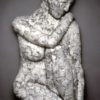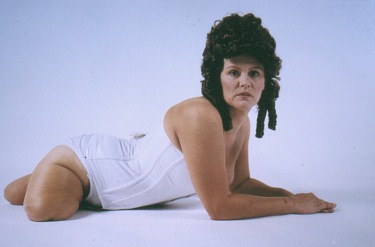Ronald Parisi
“Sensuality & Disability:” L’Histoire de Jillian I, 479/9A
color photograph
16 x 20 in.
This suite, L’Histoire de Jillian 1, part of my larger photographic essay entitled “Sensuality and Disability”, continues my quest to destigmatize disability in general by providing positive imagery of women with disabilities. By placing my model in a more historical context by use of costume, hair style and primitive prosthetics, I am attempting to counter the negative preponderance of pre-photographic, pre-literate images and stories of disability that have so formed our current opinions.
Hieronymous Bosch is an early recorder of disability. His pejorative painted images of hobbling, ugly and disfigured individuals, populating the lower regions of his paintings, especially in his Circles of Hell, reinforced the societal (and religious) view that to be disabled was to be marked, stigmatized and punished for some evil. The artist George Groz and the photographer, Joel Peter Witkin would further these views in their work in more modern times.
This view has been softened somewhat recently and perhaps the prevailing attitudes now might be construed as more enlightened. However they are still suffused with paternalism, control, and notions that the disabled are infantile, dependent and asexual. Rather than cast the disabled in Hell, we just like them not to be present (as in discrimination) and if they are present, like them and their disability to be invisible (wear skirts to the floor, cover their diseased limbs with blankets or put little black rectangles over their eyes as in medical photographs). Despite these advances, the population in general still does not totally view the disabled as individuals or at least as individuals capable of independence, thought, or sexuality.
Through my photographs, I am attempting to dispel these notions in the viewers mind. Most of us have never seen a legless person. Our immediate reaction may be horror or revulsion, pity or embarrassment. However one does not only feel these reactions when viewing my photographs. At very least one feels an ambiguity. Those ingrained reactions may be present, but there is much more presented here. Jill, the subject before you does not seem tortured or guilty, nor is her form grotesque. She displays equanimity and has a self-knowledge and assuredness that heightens her allure and attractiveness. I feel this is a portrait of a powerful woman that carries my themes forward with less perhaps misguided intervention on my part. Jill’s magic power overwhelms our preconceived notions. She causes us to see beyond our prejudices and think about who is before us.
© Ronald Parisi



